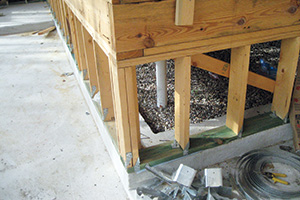“As a custom builder, you are always looking to differentiate yourself,” says Jeffrey Harrington Homes President Mark Jeffrey, whose homes often feature raised wood floors. “In our mind, it is the best way to build a foundation.”
Jeffrey Harrington Homes has been building custom homes in the Houston area since the 1960s. President Mark Jeffrey says that although floodplain consideration may be the primary reason many houses around Houston are built raised, other factors – including technical advancements and aesthetics – are generating builder interest. “It’s changing fast. Five years ago, only in certain areas would people consider raised foundations. Now it’s being rapidly accepted and a lot of builders who do it regularly appreciate it,” says Jeffrey. “And I believe the preference from consumers is changing.”
Jeffrey Harrington Homes has employed many different foundation types in recent years but now is encouraging its clients to choose a raised foundation with a crawlspace. “In our mind, it is the best way to build a foundation. It keeps the house cooler in the summer – which is our primary design consideration – and it’s easy to get under the house and do the repairs if you need to make adjustments because of shifting soil conditions,” Jeffrey says. “My understanding is that (the Houston area) has some of the worst soil conditions in the country.”
 This Jeffrey Harrington home features a wood stem wall foundation on grade beam. “We have done lots of different foundations over the last few years and we’ve really tried to push our clients more and more to a raised foundation with a crawlspace,” says Jeffrey.
This Jeffrey Harrington home features a wood stem wall foundation on grade beam. “We have done lots of different foundations over the last few years and we’ve really tried to push our clients more and more to a raised foundation with a crawlspace,” says Jeffrey.
Raised wood floor assemblies may be constructed on any soil type. In fact, they perform very well even on problematic soils, such as expansive clays which often crack conventional slabs. And while any foundation can settle, a raised wood floor system makes it easy to level or repair a shifting foundation. A raised wood floor crawlspace is also a convenient location for plumbing and ductwork – through floor trusses or between joists – which can be easily accessed for modification or repair. Repair accessibility is a key benefit of raised foundations that Jeffrey wants to improve upon even more.
“Our intent is to move to design brackets that hold the floor joists in place in a manner that we could make adjustments easily if we need to. We’re even thinking about offering a service where we annually check the customer’s foundation to see if they have any shifting. We would crawl underneath the foundation with a laser level – we would have previously marked all of the piers – so in just a few minutes we could identify if there has been any shifting and then adjust as needed.”
That kind of technical advancement can give a builder a leg up on the competition. “As a custom builder, you are always looking to differentiate yourself from everyone else. We tend to be earlier adopters of technology, as long as we feel there is a solid base for it,” says Jeffrey. “I just believe raised wood floors are the right way to go.”